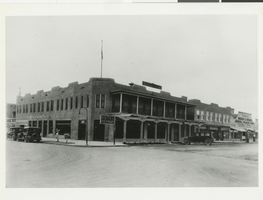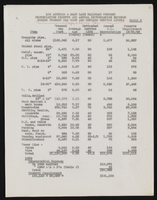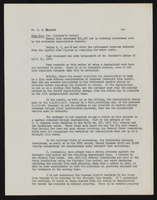Search the Special Collections and Archives Portal
Search Results

Photograph of the front exterior of the Hotel Nevada (Las Vegas), circa 1910
Date
Archival Collection
Description
Hotel Nevada after the addition of a balcony. Transcribed from photo sleeve: "by Florence Lee Jones ... March, 1969. Early Las Vegas History. The Hotel Nevada, at the Southeast corner of Main and Fremont Streets, is the oldest continuous hotel business in Las Vegas, although it has been known as Sal Sagev (Las Vegas spelled backward) since 1928. The hostelry started as a tent in 1905, but the late John Miller soon erected a permanent building, shown above, which provided the most luxurious accommodations and the best food in Las Vegas for many years. In the 1930's the Sal Sagev Hotel had one of the three elevators in town. A private dining room was a popular place for private parties for the elite of the town. The hotel is now owned and operated by Miller's son, Abe Miller, and his daughter, Mrs. Sherman E. Nugent. The Golden Gate Club now occupies much of the first floor of the building. On the North side of the building is a sign "Bank of Southern Nevada", which was the second bank established in Las Vegas. (The other was the First State Bank.) Started by John F. Miller, Ed Von Tobel, Sr., Will Beckley, Attorney Frank Stevens, and Hal D. Buzick, the Bank of Southern Nevada was an important factor in Southern Nevada's economy. During the 1930's and the Depression, the federal government issued restrictive orders on bank operations. The reaction of the independent Las Vegans was 'No guy in Washington is going to tell us how to run our bank.' ... So they paid off all the depositors and closed the bank. The Rhoads & Rhoads General Machine Works (extreme right) was one of the first automobile agencies in town - the start of Community Chevrolet."
Site Name: Hotel Nevada
Address: 1 Fremont Street
Image
William Hillman Shockley Photograph Collection
Identifier
Abstract
The William Hillman Shockley Photograph Collection (1875-1925, 1951) contains black-and-white photographs documenting mining operations at the Mount Diablo Mine and Millworks in Candelaria, Nevada. It also includes photographs of nearby operations including the Northern Belle Mine and the Princess Mill. The collection contains photographs of Shockley, his son, William Bradford Shockley, as an infant, as well as images of Shockley’s brothers, Walter A. Shockley and George Shockley.
Archival Collection
Grace Hayes Photograph Collection
Identifier
Abstract
The Grace Hayes Photograph Collection consists of black-and-white photographic prints and negatives from approximately 1890 to 1980. The collection includes personal photographs of Hayes and her son Peter Lind Hayes and publicity photographs from Hayes's entertainment career.
Archival Collection
Bob McCaffery Collection on the Save the Hughes Flying Boat Campaign
Identifier
Abstract
The Bob McCaffery Collection on the Save the Hughes Flying Boat Campaign (1980-1983) documents efforts by activists to preserve the plane from destruction and its subsequent acquisition by the Aero Club of Southern California in 1980. The collection contains photographs and newspaper clippings about the Hughes H-4 Hercules flying boat nicknamed the "Spruce Goose" from the 1980s.
Archival Collection
Sadie and Hampton George Papers
Identifier
Abstract
The Sadie and Hampton George Papers (1874-1948) consist primarily of the incoming and outgoing correspondence of Sadie Kiel George and her husband, Hampton George, regarding proposed land and mineral rights sales. The collection also includes some personal correspondence, and two of the most significant letters in the collection deal with the deaths of brothers William and Edward Kiel, Sadie's uncles, who were found dead at the Kiel Ranch in October 1900. Also included in the collection are receipts, cancelled checks, tax notices, mining claims, and land deeds.
Archival Collection
George Knox Roth Collection
Identifier
Abstract
The George Knox Roth Collection (1959-1980) consists of newspaper clippings (including photocopies), magazine articles, newsletters, technical reports and publications, correspondence, notes, and photographs relating to the Atomic Energy Commission, the environmental impact of nuclear testing in Nevada, Nevada mining, Airwest and the Hughes Airport, and other aspects of Howard Hughes’ Nevada operations. The George Knox Roth Collection also includes correspondence and expense reports related to his own company, General Research Consultants.
Archival Collection
Transcript of interview with Hank Greenspun by Tony Bleeker, 1975
Date
Archival Collection
Description
Brief interview with Hank Greenspun by student Tony Bleeker. Greenspun speaks about changes in southern Nevada over the years, including politics, gaming and the economy. He mentions the role of the newspaper industry to provide "balance" in society.
No release form is on file for this interview. The interview is accessible onsite only, and researchers must seek permission from the interviewee or heirs for quotation, reproduction, or publication. Please contact special.collections@unlv.edu for further information.
Text

Brandon Snook oral history interview: transcript
Date
Archival Collection
Description
Oral history interview with Brandon Snook conducted by Barbara Tabach on March 14, 2018 for the Remembering 1 October Oral History Project. In this interview, Colonel Brandon Snook describes his military career as a trauma surgeon and his job at Nellis Air Force Base in Las Vegas, Nevada, where he has been stationed since 2004. He shares details about Sustained Medical and Readiness Trained (SMART), a program that brings physicians, nurses, and technicians from the around the world to the University Medical Center of Southern Nevada (UMC) for intensive medical training. Snook also discusses the night of the October 1, 2017 mass shooting when he and others from Nellis were called in to UMC to treat the injured.
Text


